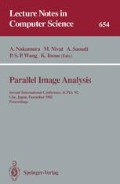Abstract
This paper describes, in a multiresolution environment, a method for 2-D object recognition which relies on a linguistic description of the object contour at different resolution levels. The object is firstly digitized at the maximum resolution level and then, by using a special smoothing technique for avoiding the addition of noise, is represented at different resolution levels until the coarsest level. A parallel, context sensitive grammar (Kirsch-like), is then used for defining production rules which describe the evolution of the contour description (following the production rule) between levels. In order to recognize the object, a matching must be performed between its string descriptions and those of prototype objects at each corresponding resolution level. The main advantages of this approach are computational efficiency (due to fast search on a coarse representation guiding the detection of contour segments on levels at higher definition) and rotation independence as well as noise immunity.
This work has been partially supported by the Italian National Research Council. Progetto Finalizzato “Siatemi Informatici e Calcolo Parallelo”, Sottoprogetto Calcolo Scientifico per Grandi Sistemi.
Preview
Unable to display preview. Download preview PDF.
References
Structured Computer Vision. S. Tanimoto and A. Klinger Eds., Accademic Press, New York, 1980.
Multiresolution Image Processing and Analysis, A. Rosenfeld Ed., Springer-Verlag, 1984.
Pyramidal Systems for Computer Vision. V. Cantoni and S. Levialdi Eds., Springer-Verlag, 1986.
M. D. Kelly, “Edge detection in picture by computer using planning”, in Machine Intelligence 6. B. Meltzer and D. Miche Eds., University of Edimburgh Press, pp. 379–409, 1971.
P. J. Burt, “Attention Mechanisms for Vision in a Dynamic World”, Proc. 11th Int. Conf. on Pattern Recognition, 1988, pp. 977–987.
C. R. Dyer, “Multiscale Image Understanding,” in Parallel Computer Vision, L. Uhr, ed., Orlando, FL: Academic Press, 1987, pp. 171–213.
A. Califano, R. Kjeldsen, R. M. Bolle, “Data and Model Driven Foveation”, Proc. 10th Int. Conf. on Pattern Recognition, 1990, pp. 1–7.
C. R. Carlson, R. W. Klopfenstein, and C. H. Anderson, “Spatially Inhomogeneous Scaled Transforms for Vision and Pattern recognition”, Optics Letters, vol. 6, pp 386–388, 1981.
C. Braccini, and A. Grattarola, “Scale-invariant Image Filtering with Point and Line Symmetry,” in Digital Image Analysis, S. Levialdi, Ed., Pitman, London, pp. 183–192, 1984.
Eve Movements and Vision. A. L. Yarbus, Plenum Press, New York, 1967.
D. H. Ballard, “Generalizing the Hough Transform to detect arbitrary shapes”, Pattern Recognition, Vol. 13, No 2, pp. 111–122, 1981.
K. S. Fu, “Recent developments in pattern recognition,” IEEE Transactions on Computers, Vol C-29, No 10, 1980, pp. 845–854.
R. A. Kirsch, “Computer Interpretation of English Text and Picture Patterns”, IEEE Trans. on EC 14, 1964, pp.363–376.
M. F. Dacey, “The Syntax of a Triangle and some other Figures”, Pattern Recognition 2, 1970, pp. 11–31.
P. J. Burt, “The Pyramid as a Structure for Efficient Computation”, in Multiresolution Image Processing and Analysis, A. Rosenfeld Ed., Springer-Verlag, 1984, pp. 6–35.
N. Nilsson, Problem Solving Methods in Artificial Intelligence, McGraw Hill, New York, 1971.
R. S. Michalsky, “Pattern Recognition as Rule-Guided Inductive Inference”, IEEE Trans. on PAMI, Vol. 2, N∘ 4, 1980.
W. H. Tsai, K. S. Fu, “Attributed Grammar: a tool for combining syntactic and statistical approaches to pattern recognition”, IEEE Trans. on Systems, Man and Cybernetics, Vol. SMC-10, No 12, 1980, pp. 873–884.
Author information
Authors and Affiliations
Editor information
Rights and permissions
Copyright information
© 1992 Springer-Verlag Berlin Heidelberg
About this paper
Cite this paper
Cantoni, V., Cinque, L., Guerra, C., Levialdi, S., Lombardi, L. (1992). Describing objects by a multi-resolution syntactic approach. In: Nakamura, A., Nivat, M., Saoudi, A., Wang, P.S.P., Inoue, K. (eds) Parallel Image Analysis. ICPIA 1992. Lecture Notes in Computer Science, vol 654. Springer, Berlin, Heidelberg. https://doi.org/10.1007/3-540-56346-6_30
Download citation
DOI: https://doi.org/10.1007/3-540-56346-6_30
Published:
Publisher Name: Springer, Berlin, Heidelberg
Print ISBN: 978-3-540-56346-4
Online ISBN: 978-3-540-47538-5
eBook Packages: Springer Book Archive

